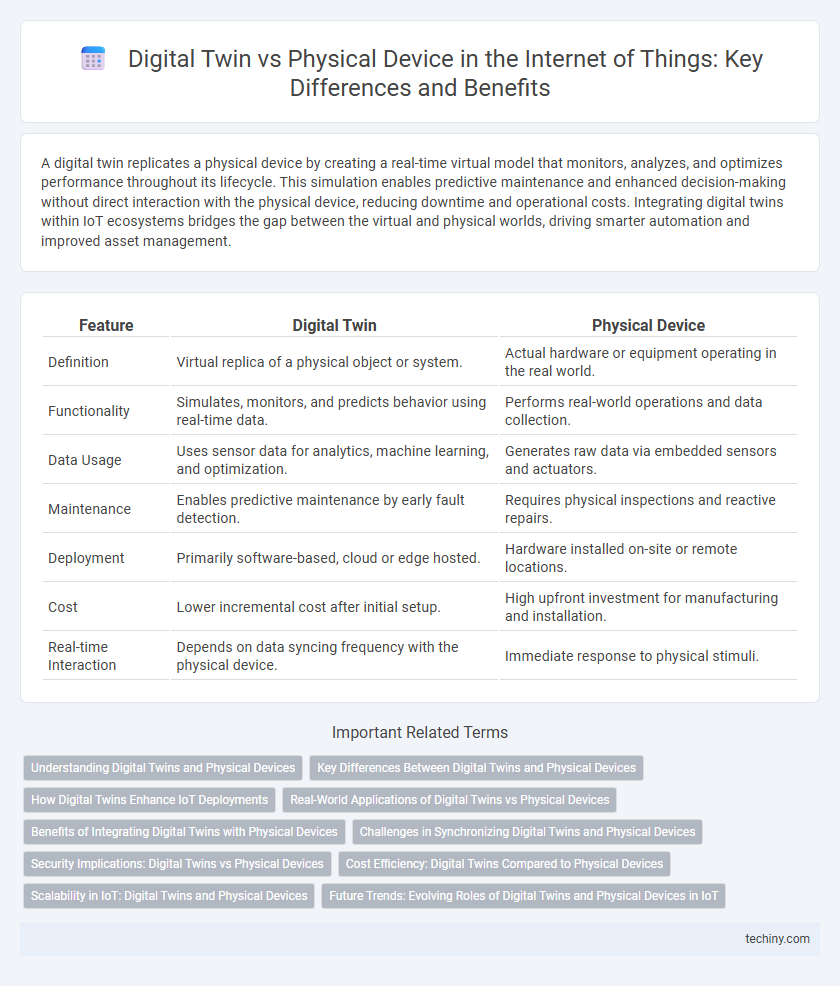A digital twin replicates a physical device by creating a real-time virtual model that monitors, analyzes, and optimizes performance throughout its lifecycle. This simulation enables predictive maintenance and enhanced decision-making without direct interaction with the physical device, reducing downtime and operational costs. Integrating digital twins within IoT ecosystems bridges the gap between the virtual and physical worlds, driving smarter automation and improved asset management.
Table of Comparison
| Feature | Digital Twin | Physical Device |
|---|---|---|
| Definition | Virtual replica of a physical object or system. | Actual hardware or equipment operating in the real world. |
| Functionality | Simulates, monitors, and predicts behavior using real-time data. | Performs real-world operations and data collection. |
| Data Usage | Uses sensor data for analytics, machine learning, and optimization. | Generates raw data via embedded sensors and actuators. |
| Maintenance | Enables predictive maintenance by early fault detection. | Requires physical inspections and reactive repairs. |
| Deployment | Primarily software-based, cloud or edge hosted. | Hardware installed on-site or remote locations. |
| Cost | Lower incremental cost after initial setup. | High upfront investment for manufacturing and installation. |
| Real-time Interaction | Depends on data syncing frequency with the physical device. | Immediate response to physical stimuli. |
Understanding Digital Twins and Physical Devices
Digital twins are virtual replicas of physical devices that enable real-time monitoring, simulation, and analysis of their performance within the Internet of Things ecosystem. Unlike physical devices, digital twins provide actionable insights through continuous data synchronization and predictive algorithms, enhancing operational efficiency and maintenance planning. Understanding digital twins involves recognizing their role in bridging the physical and digital worlds, optimizing asset management and enabling proactive decision-making.
Key Differences Between Digital Twins and Physical Devices
Digital twins are virtual replicas of physical devices that simulate real-world conditions and behavior using real-time sensor data, enabling predictive maintenance and performance optimization. Unlike physical devices, digital twins exist solely in the digital environment and allow for testing scenarios without risk or downtime. Key differences include the ability of digital twins to provide analytics and insights beyond the physical device's capabilities, supporting proactive decision-making in IoT ecosystems.
How Digital Twins Enhance IoT Deployments
Digital twins create precise virtual replicas of physical IoT devices, enabling real-time monitoring, simulation, and predictive maintenance. These digital counterparts facilitate data-driven insights, reducing downtime and operational costs while optimizing performance across connected systems. By bridging the physical and digital worlds, digital twins enhance decision-making and accelerate innovation in IoT deployments.
Real-World Applications of Digital Twins vs Physical Devices
Digital twins enable real-time monitoring and predictive maintenance by simulating physical devices in virtual environments, improving efficiency in manufacturing, smart cities, and healthcare. Unlike physical devices, digital twins provide dynamic data analytics and scenario testing without interrupting actual operations, reducing downtime and costs. Integration of digital twins with IoT sensors enhances decision-making accuracy, offering a proactive approach to asset management and operational optimization.
Benefits of Integrating Digital Twins with Physical Devices
Integrating digital twins with physical devices enhances real-time monitoring, enabling predictive maintenance that reduces downtime and operational costs. This synergy improves decision-making accuracy by providing comprehensive data analytics and simulations based on live device conditions. Enhanced product lifecycle management and faster innovation cycles result from continuous feedback loops between virtual models and their physical counterparts.
Challenges in Synchronizing Digital Twins and Physical Devices
Synchronizing digital twins with physical devices in the Internet of Things faces significant challenges due to real-time data latency, network reliability, and sensor inaccuracies. Maintaining high-fidelity data consistency demands advanced algorithms for error correction and efficient communication protocols to handle intermittent connectivity. Scalability issues arise when managing numerous devices, requiring robust edge computing solutions to process and update digital twins promptly.
Security Implications: Digital Twins vs Physical Devices
Digital twins enable continuous monitoring and real-time simulation of physical devices, enhancing anomaly detection and predictive security measures. Unlike physical devices, digital twins can be isolated within controlled environments, reducing exposure to external cyber threats while providing a secure platform for vulnerability testing. However, synchronization between digital twins and physical devices requires robust encryption and authentication protocols to prevent data manipulation and unauthorized access.
Cost Efficiency: Digital Twins Compared to Physical Devices
Digital twins significantly reduce costs by enabling virtual testing, monitoring, and maintenance, eliminating the need for multiple physical prototypes or frequent device replacements. These digital replicas allow real-time performance analysis and predictive maintenance, which lowers operational expenses and prevents costly downtime. Investing in digital twin technology provides scalable, efficient asset management, outperforming traditional physical device expenditures over time.
Scalability in IoT: Digital Twins and Physical Devices
Digital twins enhance scalability in IoT by enabling virtual replication of physical devices, allowing extensive monitoring and testing without additional hardware costs. Physical devices face constraints in scalability due to limitations in production, deployment, and maintenance resources. Leveraging digital twins accelerates IoT expansion by facilitating rapid prototyping and real-time simulation at scale.
Future Trends: Evolving Roles of Digital Twins and Physical Devices in IoT
Digital twins are expected to become increasingly autonomous, leveraging AI and machine learning to simulate and optimize physical devices in real-time within IoT ecosystems. Physical devices will integrate more sophisticated sensors and edge computing capabilities, enabling seamless interaction with their digital counterparts for predictive maintenance and enhanced operational efficiency. The convergence of digital twins and physical devices will drive smarter smart cities, industrial automation, and personalized healthcare solutions by ensuring continuous synchronization and adaptive feedback loops.
Digital twin vs Physical device Infographic

 techiny.com
techiny.com